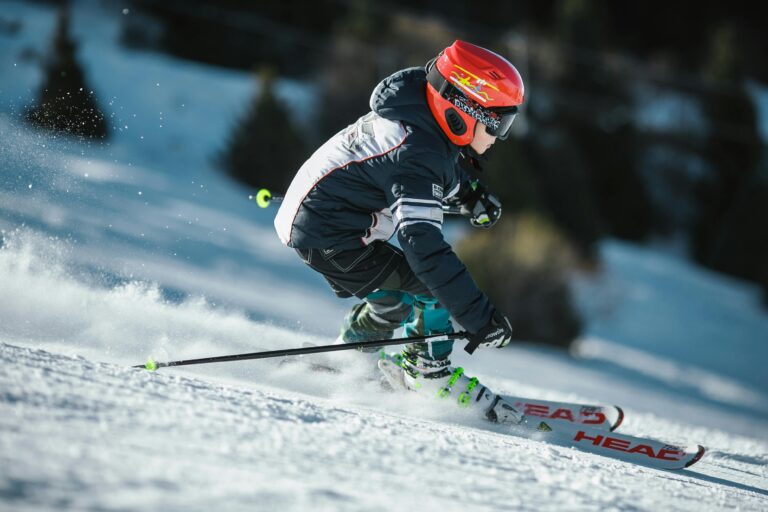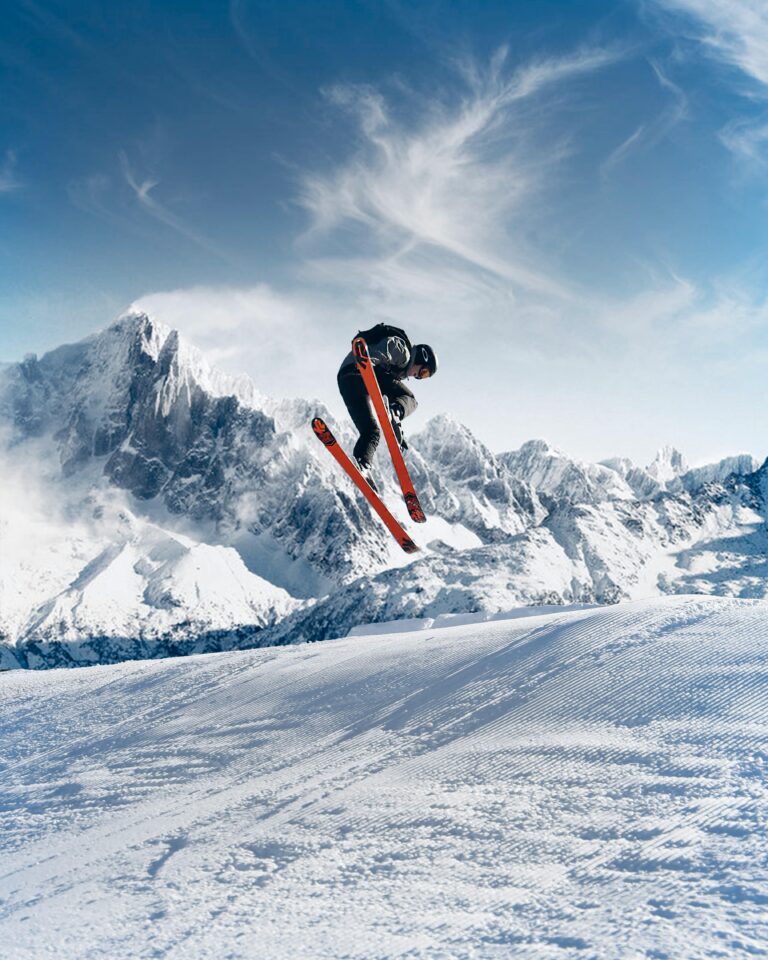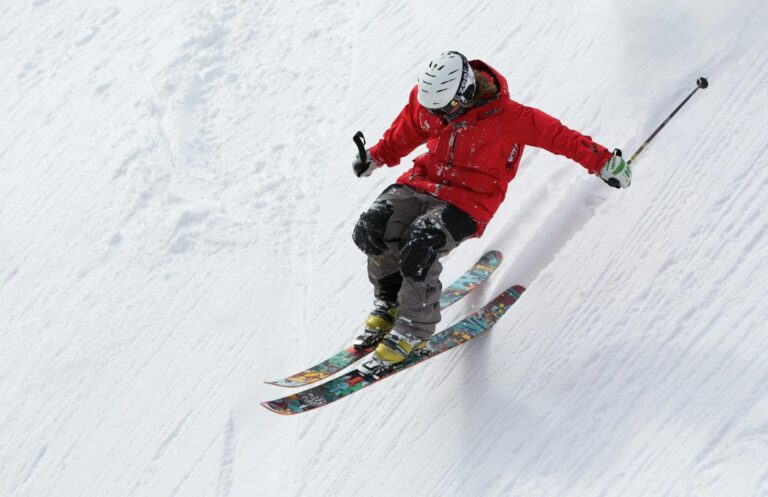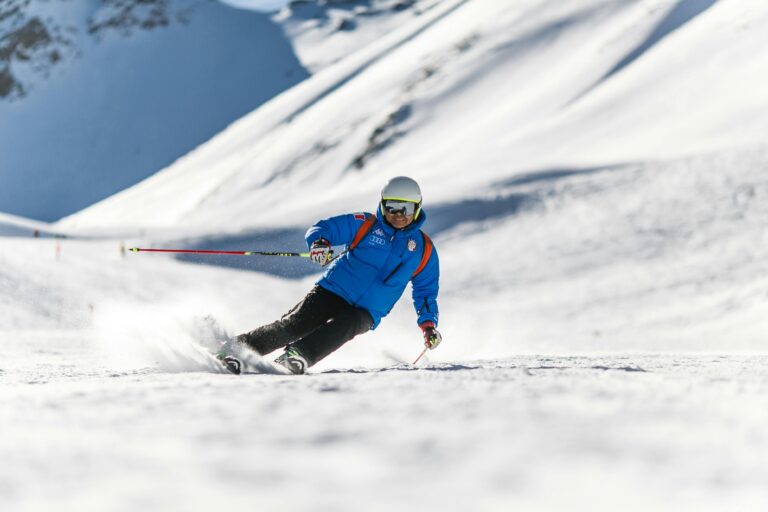Have you ever looked at those sleek, daring skiers effortlessly carving down the mountains and thought, “Could I ever do that?” Well, the answer is a resounding yes! Age is just a number when it comes to learning new skills, and skiing is no exception. Regardless of your age, you can embrace the thrill of the slopes, and this blog will guide you through the wonderful world of skiing and its many benefits for everyone.
Can You Really Learn to Ski at Any Age?

Skiing is often perceived as a young person’s sport, associated with carefree teenagers and athletic young adults gliding effortlessly down powdery slopes. However, the truth is that anyone, regardless of age, can learn to ski. Many success stories abound, showcasing individuals starting their skiing journey well into their later years including 60s and 70s.
Real-Life Learning Examples
Countless inspiring tales confirm that there’s no age limit to picking up skiing. For instance, individuals in their 60s and 70s have begun skiing, proving that a passion for snow sports can emerge at any point in life. There are even people skiing at 100 as you can see in the above videos.
And these are only two who actually recorded their experience and shared it with the world, in reality there are countless people skiing even in their late 70s, 80s.
Well if they can ski, so can you!
Nowadays Personally designed programs for adult learners, including those who may have never set foot on skis, have flourished across ski resorts worldwide. These programs often emphasize fun, safety, and community, creating an inviting atmosphere for new skiers.
Understanding Physical Capabilities
While physical ability can influence how quickly one learns to ski, it shouldn’t deter anyone from trying. For example, younger individuals might have quicker reflexes and more stamina, but this doesn’t mean older beginners cannot effectively learn. Physical fitness and mobility can vary widely among individuals of the same age; therefore, it’s essential to focus on personal capability rather than age alone.
Debunking Age Myths
Common misconceptions abound around skiing, especially regarding age. Many believe that skiing is too risky for older adults or that the learning curve is insurmountable. However, skiing is about technique, balance, and practice rather than sheer physicality. Newer teaching methods focus on gradual learning, emphasizing safety and proper technique. As a result, many older beginners find themselves enjoying the slopes safely and effectively.
For additional insights into skiing, you might want to check out the following articles: Skiing is Dangerous – An Overview and Is Skiing Hard? A Beginner’s Perspective.
What Are the Benefits of Skiing for All Ages?

Skiing offers a unique blend of thrills, physical activity, and social engagement that can benefit individuals of any age. Whether you’re a child mastering your first turn, a teenager racing down the slopes, or a senior discovering the joy of gliding through the snow, the advantages of hitting the mountains extend far beyond just recreation.
Physical Fitness and Coordination Improvement
Skiing is not just an exhilarating experience; it’s an all-around workout! Engaging in this winter sport involves multiple muscle groups, enhancing overall strength and coordination. Here’s how:
- Leg Strength: Skiing primarily works your quadriceps, hamstrings, and calves, building leg strength crucial for everyday activities.
- Core Engagement: Balancing on skis activates your core muscles, improving stability and posture.
- Cardiovascular Health: As a dynamic activity, skiing gets your heart pumping, enhancing cardiovascular fitness. An hour of skiing can burn up to 400-600 calories, depending on your body weight and effort level!
According to the National Heart, Lung, and Blood Institute, engaging in regular physical activity, like skiing, can significantly lower the risk of heart disease and hypertension, making it an excellent choice for promoting heart health across all ages.
Mental Health Aspects: Stress Relief and Motivation
Skiing can do wonders for your mental well-being. The combination of adrenaline, breathtaking views, and the sheer joy of flying down a slope can provide significant psychological benefits:
- Stress Relief: Being out in nature has been shown to reduce stress hormone levels. The enjoyment of skiing can act as a natural antidote to anxiety.
- Boost in Confidence: Mastering a turn or conquering that challenging slope can help build self-esteem. The accomplishment fostered by skiing can translate into other areas of life, boosting overall motivation.
- Mindfulness and Presence: The focus required to ski well encourages a mindfulness that can be therapeutic. As you navigate the slopes, you become immersed in the present moment, letting go of distractions.
In fact, research from the American Psychological Association highlights how outdoor activities like skiing can lead to improved mood and decreased feelings of depression and anxiety.
Social Connections Built Through Skiing Communities
Skiing serves as a fantastic platform for building social networks. It encourages interactions and creates lasting friendships:
- Community Engagement: Whether it’s with family, friends, or fellow skiers at the ski resort, skiing allows for quality bonding experiences. Ski trips foster camaraderie, shared challenges, and collective achievements.
- Inclusion in Clubs and Events: Many ski resorts host community events, races, and workshops that welcome skiers of all ages. Participating in these activities can expand your social circle and bring a sense of belonging.
- Lifelong Friendships: Numerous stories abound of friendships formed on the slopes that have lasted for decades. This sense of community can be particularly enriching for older adults who may seek new social engagements as they age.
What Is the Best Age to Start Skiing?
Children: The Early Introducers
Many ski schools cater to children as young as three-four years old. These programs are often designed to introduce basic skiing concepts through play-based activities. Starting early has several advantages:
- Natural Flexibility: Younger children typically possess greater physical flexibility and quicker learning adaptability.
- Fun-Focused Learning: Programs for kids emphasize fun and social skills, reducing performance pressure and encouraging a love for the sport.
- Community Engagement: Learning in group settings fosters social connections, which can enhance motivation and enjoyment.
In fact, many instructors agree that the best time for children to begin skiing is around the ages of 5 to 7, as they start to develop the coordination and strength needed for the slopes.
Teens: Fine-Tuning Skills
Teenagers present a slightly different dynamic. Typically, they are more physically coordinated and capable of grasping advanced techniques more quickly than younger children. These frameworks are substantial in promoting both skill development and independence:
- Physical Capabilities: Their bodies are more adept at handling the physical demands of skiing, from enduring longer sessions to mastering balance and control.
- Social Dynamics: Skiing can be a fantastic opportunity for bonding with peers, peer pressure being transformed into motivation to improve and enjoy this exhilarating sport together.
Professional ski instructors often recommend that if teens are not exposed to skiing by this age, they are not too old to learn! In fact, many ski resorts offer specialized classes for teenagers, ensuring they have a rewarding experience.
Adults: The Comeback Kids
Adults, including novice skiers aged 20 to 50+, can start without worrying about their age holding them back. While older adults may face some physical limitations due to stamina or joint health, many succeed by training and preparing in advance.
- Fitness Preparation: Engaging in a fitness routine that focuses on strength, balance, and flexibility can significantly ease the learning curve.
- Supportive Environments: Many adult learners thrive in environments encouraging camaraderie and mutual support, making group classes a great option.
- Value of Experience: Adults often bring a more profound understanding of the need for caution, which can translate into safer and more thoughtful skiing experiences.
Seniors: Embracing New Challenges
To the surprise of many, there’s no upper age limit to starting skiing. Numerous seniors have taken on new challenges and learned to ski well into their 70s and even 80s. The key considerations for older beginners include:
- Physical Conditioning: Regular exercise that focuses on building core strength and maintaining flexibility can help mitigate risks associated with falls.
- Adaptive Instruction: Many ski schools offer tailored programs for older learners, focusing on a slower pace, longer instructional periods, and specialized equipment.
- Mental Readiness: It’s essential for older learners to approach skiing with an open mindset, understanding that fear is natural but can be overcome with persistence and practice.
Expert Recommendations
According to the Ski and Snowboard Instructors Association, starting early offers the most advantages, yet they also advocate that it is never too late to learn. Proper instruction, safety equipment, and a supportive learning environment can enhance the skiing experience for any age group.
Ultimately, the best age to start skiing really depends on individual readiness, physical capabilities, and interest in the sport. Whether you’re a parent wondering about when to introduce your child to the slopes, a teenager eager to learn, or an adult looking to pick up a new hobby, skiing is an accessible and enjoyable pursuit for everyone.
Think of the slopes as an endless opportunity for growth and enjoyment—regardless of your age!
What Challenges Do Older Adults Face When Learning to Ski?
1. Physical Limitations:
As we age, our bodies may not respond as efficiently as they did in our youth. Issues such as decreased muscle mass, lower bone density, and reduced flexibility can present challenges when learning to ski. The cold weather can exacerbate these conditions, making joints feel stiff and reducing overall mobility.
For older adults considering taking up the sport, recognizing and addressing physical limitations is crucial. A well-rounded fitness routine focusing on strength, balance, and flexibility can enhance skiing readiness.
2. Concerns Over Injury:
One of the most significant fears for older adults is the risk of injury. Skiing can be hazardous due to its inherent physical demands and the possibility of falls. According to a study by the American Academy of Orthopaedic Surgeons, older skiers are at a higher risk for serious injuries like fractures or ligament tears, particularly around the knees.
Fears about falling can hold older individuals back from fully committing to the learning process. It’s vital to nurture a mindset that embraces safety through proper techniques, use of protective gear, and instruction from experienced instructors.
3. Stamina and Endurance Concerns:
Learning to ski can be both physically and mentally demanding. Older adults may have concerns about their stamina and endurance, which can affect their confidence and willingness to spend long hours on the slopes. Engaging in regular cardiovascular activities, such as walking, cycling, or swimming, can help build the necessary endurance before hitting the slopes.
4. Psychological Barriers:
Fear of falling and apprehension about the sport can exacerbate existing self-doubt. Overcoming these psychological barriers is crucial for older beginners. Many are hesitant to put themselves in a potentially dangerous situation, questioning their ability to learn a new skill later in life. This can lead to a cycle of avoidance, which makes learning to ski seem even more daunting.
5. Lack of Tailored Resources:
While many ski schools cater to beginners, few focus specifically on older adults. This can make accessing suitable lessons and resources challenging. Programs specifically designed for older learners can reduce anxiety, as they often address the unique challenges faced by older skiers. Finding ski schools that offer tailored packages for seniors can significantly improve the learning experience.
6. Equipment Limitations:
Finding the right equipment can be a daunting task, especially for older adults who might not be familiar with the latest technologies in skiing. Many ski gear brands now design adaptive equipment, but many older beginners may not know about these innovations or how they can enhance comfort and safety. Taking the time to speak with experts at ski shops can provide valuable insights.
By acknowledging and addressing these challenges directly, older adults can not only learn to ski but also enjoy a fulfilling and exhilarating experience on the slopes. With adequate preparation, education, and the right support systems, skiing can become an enjoyable pursuit for anyone, regardless of age.
How Can Older Adults Prepare to Learn Skiing?
Physical Fitness Routines
Before hitting the slopes, older adults should focus on enhancing their physical fitness, targeting strength, balance, and flexibility. A robust fitness routine can fortify your body for the demands of skiing. Here are some effective exercises:
- Strength Training: Incorporate exercises that strengthen the legs, core, and upper body. Squats and lunges can enhance leg strength, while planks and sit-ups will build core stability. Light weights can also be beneficial in enhancing muscle endurance.
- Balance Exercises: Practicing balance is crucial for skiing. Utilization of balance boards, yoga routines, and tai chi can significantly enhance stability. Consider starting with simple standing exercises on one leg before advancing to more complex moves.
- Flexibility Work: Stretching is key to preventing injuries and maintaining mobility. Regular stretching of the hamstrings, hips, and calves will ensure you remain limber on and off the slopes. Yoga is an excellent practice that combines flexibility with balance and strength.
Warm-Up Exercises and Stretches
Before skiing, approximately 10-15 minutes of warm-up should be a priority to get your blood flowing and muscles ready. Here are a few recommended stretches and warm-ups:
- Dynamic stretches: These include arm circles, leg swings, and torso twists that prepare the body for movement.
- Specific skiing stretches: Find stretches that target the muscles used while skiing. For example, wall sits can simulate the squat position often held while skiing.
Seek Professional Guidance
Taking lessons from certified instructors who specialize in teaching older beginners can make a significant difference in your learning experience. They can offer tailored instruction and ensure you learn proper techniques. Look for local ski schools that have programs designed specifically for older adults.
Mental Preparation
Skiing is not only a physical challenge but also a mental one. Here are some tips to ease any psychological barriers:
- Visualize Success: Spend time imagining yourself skiing confidently and successfully. Visualization can enhance performance and may even help reduce anxiety.
- Set Realistic Goals: Start with achievable goals, such as mastering the bunny hill before progressing to more challenging slopes. Celebrate small victories along the way.
- Connect with Peers: Skiing can be more enjoyable with a companion. Whether a family member, friend, or joining a group class, having support on the slopes can enhance confidence and enjoyment.
Resources and Classes
As mentioned, pursuing formal training can transform your skiing journey. Here are some resources to help get you started:
- Local Ski Schools: Many ski resorts offer tailored classes for older adults. Research options in your area to find a good fit.
- Community Groups: Local community centers often have recreational programs. Engaging with local skiing groups can provide opportunities for practice and camaraderie.
- Fitness Centers: Joining a local gym can offer access to fitness classes specifically aimed at older adults, focusing on building strength, balance, and endurance for skiing.
What Are Some Safety Tips for Beginners of All Ages?
Gear Up Properly
- Wear the Right Equipment:
- Helmet: A properly fitted helmet is crucial for protecting your head in case of a fall or collision. Ensure your helmet meets safety standards.
- Goggles: Protect your eyes from snow, wind, and UV rays. Look for goggles that fit snugly and offer a good field of vision.
- Clothing: Dress in layers to stay warm and dry. Moisture-wicking base layers, insulating mid-layers, and waterproof outer layers will keep you comfortable.
- Ski Boots and Skis: Ensure your boots are the right size and fit comfortably. Ski lengths should match your height and ability level as well.
Know Your Limits
- Start on Easy Slopes:
Beginners should stick to the green (easy) slopes until they gain more confidence and skill. This reduces the chances of encountering more challenging terrain too soon. Always check the difficulty level of the slope before heading down, as signs are usually posted at the top.
- Take a Lesson:
Enrolling in a ski class with a certified instructor can vastly improve your skills and safety awareness. They can teach you proper techniques, such as how to stop and turn effectively.
Though yes you can learn skiing without any lessons, completely on your own but I would still highly recommend taking one considering your age and your proneness to injuries because the right technique is super important.
Stay Visible and Aware
- Follow the Rules of the Slopes:
Understanding and adhering to the skier’s responsibility code will help avoid accidents. Skiers ahead of you have the right of way, and it’s essential to plan your run to avoid collisions. Always signal your intentions, like stopping or turning, to others on the slope to increase safety for everyone.
- Stay Alert:
Keep an eye on other skiers and be aware of your surroundings. Avoid distractions like your phone while skiing, as they might lead to accidents.
Warm Up and Maintain Fitness
- Warm-Up Exercises:
Incorporating warm-up stretches before skiing helps prepare your body and limit the risk of injuries. Focus on stretching major muscle groups, including legs, hips, and back. Exercises such as lunges, leg swings, and hip openers can improve flexibility and performance.
- Build Strength and Endurance:
Engaging in regular fitness routines can significantly enhance your skiing experience. Activities such as swimming, cycling, and yoga can improve your overall strength and balance, making it easier to control your movements on the slopes.
Use Appropriate Safety Strategies
- Always Ski with a Buddy:
Skiing with a partner not only makes the experience more enjoyable but also offers help in case of an incident. Agree on meeting points in-case you ski apart.
- Emergency Plan:
Familiarize yourself with emergency procedures at the ski resort. Know how to report an incident and where to find first aid stations.
Post-Skiing Care
- Cool Down After Skiing:
Just as warming up is essential, cooling down is equally important. Stretching after skiing can mitigate soreness and improve recovery time. Consume plenty of fluids to stay hydrated and help your body recover after a day on the slopes.
I’ve written an entire article on dangers of skiing and how you can do it safely and prevent injuries, make sure you go check that out as well after this.
How Can You Overcome Fear and Build Confidence in Skiing?
1. Understand the Source of Fear
Identifying where your fear originates is the first step to combating it. For many, fears stem from:
- Fear of Falling: The possibility of injury can be daunting.
- Fear of Judgment: Worrying about how others perceive your skills.
- Fear of the Unknown: Not knowing what to expect on the slopes.
Acknowledge these fears as valid feelings. Remember, every skier has faced similar challenges at some point, and many instructors emphasize that the journey starts with understanding and accepting these emotions.
2. Start Slow and Educated
One of the most effective ways to build confidence is through education and familiarity.
- Take Lessons: Consider enrolling in ski classes, particularly those tailored for beginners. Instruction from a qualified professional will help you learn essential techniques and safety measures without the intimidation factor. A supportive teacher can significantly enhance your experience.
- Choose the Right Terrain: Begin with gentle slopes and bunny hills designed specifically for beginners. This environment allows you to practice maneuvering and stopping without the pressure of steep inclines or faster-paced skiers.
3. Visualization Techniques
Visualization can be a powerful tool for overcoming fear. Before heading out the slopes, take some quiet time to visualize yourself skiing smoothly:
- Picture yourself gliding down the slopes effortlessly.
- Imagine enjoying the experience, feeling secure and in control.
- Focus on the sensations of the wind, the snow, and the joy of skiing.
Putting these images into your mind can prime your body for a smoother experience when you hit the snow.
4. Build Physical Fitness
Being physically prepared can help mitigate fears related to physical capability. A focused fitness regimen can enhance your strength, balance, and flexibility, which are all crucial for skiing.
- Strength Training: Focus on core and leg exercises to improve stamina and stability. Squats, lunges, and leg presses are great prolonged strength builders.
- Balance Training: Activities like yoga or Pilates can enrich your balance, which is critical for remaining upright on skis.
5. Set Realistic Goals
Establish small, incremental goals to help track your progress. For instance:
- First Goal: Successfully navigate the bunny slope.
- Second Goal: Complete two runs without falling.
- Third Goal: Ski confidently down a more challenging beginner run.
Setting these achievable benchmarks allows you to celebrate victories along the way, bolstering your confidence each step of the way.
6. Ski with Supportive Friends or Groups
Involvement in a supportive community can have an incredible impact on your skiing confidence.
- Group Lessons: Many beginners benefit from learning in groups, sharing experiences, and pushing one another to succeed.
- Ski with Friends: Having friends who either know how to ski or are also beginners can provide emotional support. They can help distract you from fears while encouraging each other through challenges.
7. Embrace Mistakes and Learn
Mistakes are an inevitable part of learning any new skill. Embrace them as part of the process rather than as failures. Learn from your falls—it’s an opportunity to assess what went wrong and how to improve.
Remember, even seasoned skiers fall. It’s how you handle those spills that shapes your skiing journey.
8. Celebrate Progress
No matter how big or small, always acknowledge and celebrate your skiing achievements.
- Keep a journal detailing your skiing experiences, noting improvements and what you’ve learned after each outing.
- Share your successes with friends or social media, creating a record of your journey that can inspire others and serve as a confidence booster for you.
What Adaptive Techniques Are Available for Older Beginners?
Learning to ski as an older adult can be a thrilling adventure, but it may come with its own set of challenges. Fortunately, many adaptive techniques can help make skiing more accessible and enjoyable for older beginners.
Adaptive Equipment
- Specialized Skis: Many older skiers opt for shorter skis that are easier to maneuver. Wider skis can provide added stability and help prevent falls, making them a great choice for beginners.
- Ski Poles with Grips: Ski poles equipped with ergonomic grips can offer better support and reduce wrist strain. Some even come with adjustable straps to accommodate different hand sizes.
- Custom Boots: Ski boots specifically designed for comfort and support can make a significant difference. Older adults might benefit from boots with a wider fit and added cushioning to reduce pressure points.
- Sitting Skiing: For those with significant mobility challenges, “sitting skiing” options provide a way to ski while seated. This technique uses a sit-ski, which allows individuals to enjoy the thrill of skiing without standing.
Adaptive Techniques in Movement
- Modified Stance: Instructors can teach older beginners to adopt a more upright posture. This approach helps maintain balance and control while reducing the strain on knees and hips.
- Gentle Progressions: Starting with gentle slopes and gradually progressing to more challenging terrain can boost confidence and allow older skiers to build their skills without excessive stress.
- Slow Turns: Focusing on making smooth, slow turns can help older skiers maintain their balance and control. Teaching techniques that emphasize carving over skidding can also enhance stability.
- Balance Training: Incorporating balance exercises off the slopes can enhance a skier’s stability. Simple activities like standing on one leg or practicing yoga can significantly help.
Tailored Instruction
- Individualized Lessons: Many ski schools offer tailored programs for older adults, ensuring that lessons match their pace and learning style. Instructors experienced in working with older beginners are invaluable.
- Small Group Classes: Learning in small groups allows for personalized attention while still providing a supportive community atmosphere. Sharing experiences with peers can help relieve anxiety and foster friendships.
- Use of Technology: Many ski instructors now incorporate video analysis to provide feedback on form and technique, making learning more interactive and effective.
- Adaptive Programs: Organizations like Easterseals and Ski and Snowboard Schools of Aspen offer specialized programs aimed at teaching skiing to individuals with varying abilities, including senior learners. Programs like these accommodate for diverse needs and build confidence within a supportive framework.
For further details on the benefits of skiing for beginners and safety tips, check out Skiing: Dangerous or Not? and learn more about the challenges that can be overcome while learning to ski as an older adult.
Testimonials of Triumph
Consider the story of “Frank,” a vibrant 72-year-old who decided to take up skiing for the first time after retiring. Initially apprehensive, Frank found himself in a ski class filled with similarly spirited seniors. Over a few weekends, he not only learned how to ski but also developed friendships with his classmates, planning regular skiing trips together. He mentions, “I never imagined I’d find this much joy and community at my age. It’s as if I’ve been given a new lease on life!”
These stories of individuals who discover skiing later in life contribute to a larger narrative: skiing can significantly improve quality of life for older adults, offering a rich blend of community, personal growth, physical wellness, and mental empowerment.
In summary, skiing goes beyond mere sport; it is a multifaceted avenue for enhancing the quality of life for older adults. The countless benefits—from physical health to emotional resilience—encapsulate skiing as a gratifying and life-affirming activity. Whether it’s gliding down a hill or connecting with like-minded peers, the value of skiing is immeasurable, proving that it’s never too late to embrace a new adventure on the slopes.
FAQ about Learning to Ski at Any Age
What are the oldest recorded learners of skiing?
It’s inspiring to know that there are successful accounts of individuals learning to ski in their 70s and 80s! Age is not a deterrent; what truly matters is your willingness and physical readiness. Stories abound of seniors who took their first lessons later in life and found joy in gliding down the slopes.
How can seniors find suitable ski lessons?
Seniors can look for local ski schools that offer beginner classes specifically designed for older students. Many ski resorts recognize the growing interest among older adults and have formed programs that prioritize safety, allowing older beginners to learn in a supportive environment. It’s advisable to check with your chosen resort beforehand to see what options are available.
What physical fitness is recommended for older beginners?
Before hitting the slopes, older beginners should focus on exercises that enhance strength, balance, and flexibility. Activities like yoga, swimming, and light weight training are beneficial. Furthermore, consider incorporating specific exercises that mimic skiing movements into your routine, including lunges and squats, to prepare your muscles effectively.
Is skiing dangerous for older adults?
Skiing does come with inherent risks, as with any sport. Older adults, in particular, may be more susceptible to injuries due to factors like decreased flexibility and stamina. However, many of these risks can be mitigated through proper preparation, education on safe skiing practices, and using the correct equipment. Always remember to listen to your body; don’t push beyond your limits.
How can beginners build confidence while skiing?
Overcoming the fear of falling or making mistakes is a common concern for beginners, especially for older learners. Some strategies to build confidence include starting on easy slopes, joining group lessons for emotional support, and practicing relaxation techniques before hitting the slopes. Remember, the goal is to enjoy the experience—every skier started as a beginner!
What conditioning activities can help prepare for skiing?
Effective conditioning activities to consider before skiing include:
– Cardiovascular exercises (like walking or cycling)
– Strength training (focusing on the legs, core, and arms)
– Balance training (yoga, pilates, or specific balance drills)
Incorporating these activities into your weekly routine can help improve your overall skiing performance and reduce the likelihood of injury.
Are there adaptive skiing programs for older adults?
Many ski resorts like Aspen Snowmass, Snowbird Utah, etc. offer adaptive skiing programs designed for people with varied physical abilities making skiing accessible for everyone, regardless of age or physical condition. Instructors use specialized equipment & techniques to provide a personalized skiing experience.
Some of the other well known programs for all ages are:
Aspen Snowmass, Colorado (USA) — Their Challenge Aspen program is highly regarded and offers adaptive ski lessons for all ages.
Breckenridge Ski Resort, Colorado (USA) — Features the Breckenridge Outdoor Education Center (BOEC), which provides adaptive ski and snowboard programs.
Park City Mountain, Utah (USA) — Home to the National Ability Center, offering extensive adaptive sports programs including skiing.
Whistler Blackcomb, British Columbia (Canada) — Offers adaptive skiing through the Whistler Adaptive Sports Program.
Mount Snow, Vermont (USA) — Provides adaptive ski lessons via the Adaptive Sports at Mount Snow program.
Can skiing really improve my quality of life as an older adult?
Engaging in skiing can enhance your quality of life by promoting social connections and providing a physical outlet that encourages active living. Many seniors have shared stories of how skiing has fostered new friendships, increased their happiness, and encouraged them to stay active. The blend of fresh air and community can have significant benefits for mental and emotional well-being.
For those looking to delve deeper into the benefits of skiing for older adults, this guide covers some insightful perspectives on the topic!
Learning to ski can be an enriching experience, no matter your age. Embracing the adventure comes with its uncommon hurdles, yet with the right mindset and preparation, skiing opens doors to joy, exercise, and community. Don’t hesitate to take that leap—your skiing journey awaits!






